Special to The Island News
While you’ve probably heard it a hundred times, washing your hands regularly and keeping them away from your face are among the most effective ways to prevent the spread of COVID-19 – or any disease.
“Although COVID-19 primarily spreads through person-to-person contact, you might also get sick by touching a contaminated surface and then touching your face,” Ashley Hildreth, RN, Patient Safety Officer at Beaufort Memorial Hospital said. “As a result, disinfecting your home, as well as items you use often — particularly outside of your home — can also protect you and your family from spreading germs.”
While “cleaning and disinfecting” are often referred to in the same breath, they are actually different things.
“Cleaning rids surfaces of dirt and grime. Disinfecting kills bacteria and viruses,” Hildreth said. “To prevent germs from spreading in your home, it’s a good idea to disinfect after you clean.”
The Dirty Dozen
As you go about your disinfecting routine, don’t forget these germy — and often overlooked — items:
Bathroom and kitchen fixtures/faucets
Car steering wheel
Credit cards, particularly after using them
Dirty clothes hamper
Handles and knobs, including those on doors, cabinets, appliances, mailboxes and cars
Keys
Light switches
Pillows
Purses, backpacks and briefcases
Remote controls, video game controllers
Smart phones, tablets and laptops
Toys
Here’s a quick reference guide for how to clean and disinfect some common items and materials:
Electronics: Cleaning recommendations vary based on brand and type of electronic, so consult the specific manufacturer’s website. As a general rule, use moisture sparingly when you clean and disinfect devices to avoid damaging your gadgets.
Fabrics: Launder according to the manufacturer’s instructions. Use the warmest water possible, and dry completely.
Hard surfaces: Clean with soap and water, then disinfect with an Environmental Protection Agency (EPA)-registered disinfectant, 70 percent alcohol solution or diluted bleach (4 teaspoons per quart of water or 1/3 cup per gallon of water). Leave disinfectant on surfaces for at least a minute for maximum effectiveness.
Stay Safe
While fearing possible exposure to harmful germs is enough to send anyone in a cleaning frenzy — be sure to go about it safely.
“It’s important to keep yourself safe while cleaning and disinfecting,” Hildreth said. “It’s a good idea to follow the Centers for Disease Control and Prevention recommended safety tips.”
These include:
Always wear disposable gloves. Discard immediately after use.
Read product labels carefully. The label will list directions for use and any important cautions.
Don’t mix. Be careful not to combine cleaning products — especially those containing ammonia with household bleach.
More does not mean better. Avoid using too much of any product. Follow label instructions for use and properly dilute solutions when the directions say to do so.
Open a window. Keep the house well ventilated to avoid overexposure to cleaning chemicals.
Watch expiration dates. Expired cleaners, including bleach, may be ineffective for disinfecting and getting rid of germs.
“Disinfecting only adds a few minutes to your cleaning routine,” Hildreth said. “But it can make a significant difference in fighting the spread of disease.”





